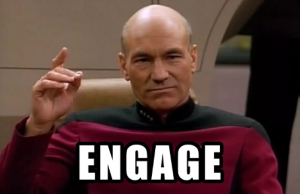September 2020
Engage
 Dawn Stevens, Comtech Services
Dawn Stevens, Comtech Services
In the Star Trek universe, Captain Jean-Luc Picard of the Starship Enterprise typically uses the catchphrase “Engage” after giving commands to his helmsmen regarding the direction and speed for travel. It’s an indication that they should carry out the command immediately and begin the journey, the equivalent of the “Go” in the more familiar phrase “On your mark…get set…go!”
Coming from an industry where word choice is critical, I find Captain Picard’s command to “Engage” to be so much richer in meaning than “Go”. While in context, it technically may simply be a shortened command to engage the engines, there is an undertone to the command that I believe should be applied outside the context of Star Trek and into our everyday lives. Should we just “Go” or should we actually “Engage”?

For example, I submit it is a very different thing to go to a party and to engage in the party once there. As an introvert, I may reluctantly go to a party (begrudgingly or out of a sense of duty), but once there, I may hide in a corner, sipping a drink and avoiding eye contact with everyone I don’t know. After the fact, my perception of the party differs greatly from other, more extroverted souls. When asked how the party went, I might comment on the buffet selection or the music choice, but largely leave the enquirer with an impression that the party was boring and maybe even poorly attended, as I will likely be unable to list who was there, let alone talk about my interactions with them. On the other hand, a person who not only went to the party, but engaged, may effuse about the party and how wonderful it was, how many people they talked to, the gossip they heard, the games they played, and so on. I will forget I even went to the party in a few days or weeks, while they might remember it and the friends they made for a lifetime.
The underlying principle is that you should not expect to get more from something than what you put in. If you simply go, you will of course arrive at your destination (barring the interference of an alien life form), but if you engage, you will experience the journey and the destination, and you will be richer for it. Picard’s command to “engage” encompasses the mission of Starfleet – to not only seek out new life forms and new civilizations, but to learn about them and from them. Not just to “go”, but to “boldly go”.
The principle, of course, applies equally well to other verbs. If I invest 10 minutes, 2 pieces of buttered bread, and a couple slices of cheese, the most I can hope for is a grilled cheese sandwich; I’m not going to get a Michelin-star five-course meal for my measly contribution. If my children simply sit in class without engaging in the subject, the classroom discussions, and the assignments, I assert that they may get by, but they are unlikely to get the best grades in the class; the effort they put in is reflected in the grades they get out. In other words, the rewards for engagement far exceed the rewards of simply going through the motions, whatever those motions may be.
In technical documentation, this principle of engagement affects us from both sides. Obviously, as in any career, we must make the decision of how much we will put into our career. Do we meekly accept the lot we’ve been dealt and work at the bottom of the totem pole, thinking of ourselves as “just technical writers”? Or do we engage with our product managers and subject matter experts, asserting our expertise and building relationships across silos? Do we simply write topics the way we always have, or do we actively look for better ways to communicate the information? In my opinion, the choice to engage in my career makes it far more rewarding than if I simply showed up for the paycheck.
On the flip side, however, we also see and experience the impact of our user’s engagement choice. When our users are not engaged, the documentation remains unused, calls may escalate to tech support, and dissatisfaction may rise. In several of my classes, I raise the issue to participants of what is the purpose of technical documentation. Is it to inform? Educate? Enable? Engage? While we might argue the correct answer is all of the above, each of these words can require different writing strategies to achieve. Do we write to engage? And if our users are not engaged, what are they getting out of their interactions with our content? I submit that if we aren’t worried about user engagement, our documentation is not meeting its full potential, and we as technical writers may begin to believe it when others assert that no one reads the documentation.
How do we design for engagement? Clearly, the answer is rooted in knowing your audience well, in understanding how to grab and hold their attention, but these strategies cannot be easily itemized in a single director’s column. I can, however, point to a great source of answers to this question: CIDM’s ConVEx event debuts later this month, September 21-23 and features industry leaders sharing their insights on this and other subjects. The library holds a plethora of presentations on user-centric design strategies, and the live event offers opportunities to interact with the presenters in more detailed conversations, as well as additional panels and keynotes on the subject. I encourage you to check it out at conVEx.InfoManagementCenter.com.
But more than that, I encourage you to engage. The question of engagement has weighed
heavily on my mind as we’ve designed this event. In the past, someone might have asked if you were “going” to a conference, and indeed many people have simply come to our conferences. If that’s what you’re looking for, ConVEx does offer you the ability to passively partake of the expertise in the presentations. However, by now I hope I’ve driven in the message that you get back in measure what you put in. ConVEx is designed for engagement, providing ample opportunities to interact with speakers and fellow attendees. Use the Slack channels to socialize and converse. Go to the Zoom rooms to ask questions of speakers. Bond with others during breaks over a common favorite drink or meal. We’ve set up the event to be a new way to learn and network. It’s up to you to, as Captain Picard also says, “Make it so!”

